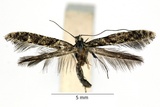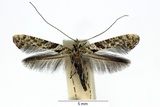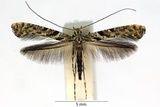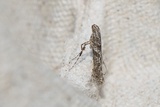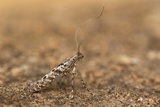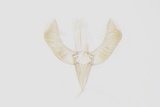Caloptilia cuculipennella (Hübner, 1796) Species
Last modified: Nov. 25, 2024, 11:44 a.m.
A fairly common species throughout Belgium. With the present knowledge of leafmines, more frequently observed than in the past.
Details
- Classification
- Family: Gracillariidae > Subfamily: Gracillariinae > Tribus: Gracillariini > Genus: Caloptilia > Species: Caloptilia cuculipennella
- Vernacular names
- Grauwe steltmot (NL), Feathered slender (EN), Liguster-Blatttütenfalter (DE)
- Synonyms
- Caloptilia alaudella (Duponchel, 1840) and Parornix avellanella (Stainton, 1854)
- First mention in Belgium
- De Fré Ch. 1858. Catalogue des Microlépidoptères de la Belgique. — Annales de la Société entomologique belge 2: 45–162. On page 147 (as alaudellum). view page
- Status
-
Native
Distribution
Caterpillar
Yellowish with light brown head capsule.
Mine
First instars live in a transparent serpentine mine in which the frass is arranged in a continuous line. Later on, the mine becomes a whitish blotch with the black frass concentrated in one corner. When this blotch is enlarged, the leaf edge is turned over, and the last instars live freely on the leaf.
See also gracillariidae.net and bladmineerders.be.
Bionomics
The free-living caterpillars construct a typical, downwards-turned, conical leaf roll, sometimes called pepperbox, of which the bases are the broadest. The last instar bites a circular exit hole in that papperbox.
It pupates in a pure white hammock-like cocoon which is attached between this exit hole and another point in the pepperbox. After the emergence of the adult, the pupal skin protrudes from the exit hole.
The moths are active around their food plant in the late afternoon and later come to light.
Flight periods
The adults fly in one generation a year emerging during September, overwintering, and then flying until May.
Observed on
- Host plant (species):
- Ligustrum vulgare
- Host plant (genera):
- Fraxinus, Syringa and Ligustrum
The larvae feed on Ligustrum vulgare, Fraxinus excelsior and Syringa vulgaris.
